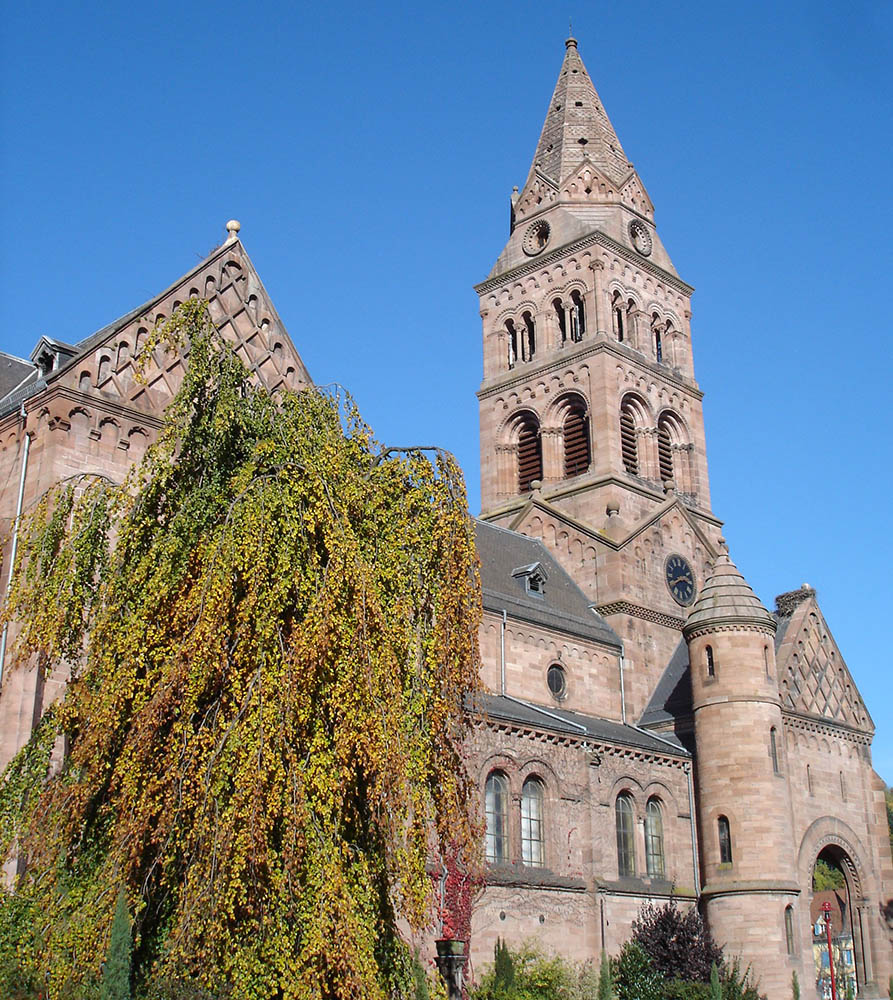Religious heritage

Churches and chapels of the Munster Valley
Munster's coat of arms features a church facade with two towers, a reminder of the long-gone major Benedictine abbey of Saint-Grégoire which once stood here. Only a few carved Romanesque-style fragments, stored at Munster town hall, were uncovered during the archaeological digs carried out on the site of this mediaeval building (on the south-eastern corner of what is today place du Marché), largely destroyed in the early 19th century.
Today it is necessary to visit the church of Saint-Jean-Baptiste in Soultzbach-les-Bains to see the sober Gothic choir built in the 14th century on the orders of the powerful lords of Hattstatt.
The last remaining examples of mediaeval architecture are the Sainte-Catherine chapel built in the 15th century among Soultzbach’s fortifications and a rare ossuary built around 1500 inside the walls of Wihr-au-Val’s cemetery, with an upstairs chapel dedicated to the archangel St Michael.
Numerous churches built in the 19th century were spared by the shelling of the First World War, including the neo-Gothic church of Saint-Martin de Wihr-au-Val (1869-73, architect: V. Heilmann), an impressive pink sandstone building located at the entrance to the area, and Munster's protestant church, which is heavily inspired by Romanesque architecture, financed by the Hartmann industrial and textile family (1869-73, architect: F. L. De Rutté).
From 1920 onwards, the post-war reconstruction effort saw the architects drawing upon different stylistic sources to build new places of worship including the votive church of Notre-Dame-de-l’Emm in Sondernach (1928-31, architect: P. Kirchacker-Demant), dedicated to the troops who fell on the field of battle, and the church of Notre-Dame-de-l’Immaculée-Conception in Mittlach (1927-29, architect: Ch. Schoffit) which borrowed Romanesque artistic features. The church of Saint-Barthélemy in Muhlbach-sur-Munster (1927-29, architect: Ch. Schoffit) is directly inspired by southern German baroque religious architecture which was often very colourful.
Examples of catholic and protestant religious art
The art of sculpture has left us a few noteworthy works, with the finest examples being concentrated in the church of Saint-Jean-Baptiste in Soultzbach-les-Bains: the Eucharistic cupboard dedicated to Saint Christophe, the gravestone of the couple Jakob von Hattstatt-Margarethe von Rathsamhausen and the statue of Saint Sébastien (secondary south altar) date from the first quarter of the 15th century; a gravestone featuring the effigy of a noble woman, married to a Hattstatt knight, is an example of mid-14th century art.
At the church of Notre-Dame-de-l’Emm in Sondernach, some doubts remain concerning the Virgin of Pity scene: although it features drapery typical of the 1500s, it could well be an excellent copy from the early 1900s. However, it is baroque art which takes pride of place due to the presence in Soultzbach-les-Bains from 1715-20 onwards of one of Alsace's finest carpenters and sculptors: Jean Antoine Werlé.
His workshops produced the highly decorative altars of the churches of Soultzbach-les-Bains and Wihr-au-Val (only four statues remain here), the cross in the Sainte-Croix chapel of pilgrimage in Wihr-au-Val and that of the chapel of Sainte-Catherine in Soultzbach-les-Bains. After 1918, it was the Munster workshop of the carpenter Joseph Driesbach which completely refurbished numerous churches, without ever adopting the Art Deco style. The catholic churches of Muhlbach-sur-Munster and of Stosswihr (Ampfersbach) feature altars and chairs in the 18th century Rhenish style, and a full range of interior furniture necessary to the ceremonies.
At Notre-Dame-de-l’Emm in Sondernach, the Italian sculptor Gino Cavallini was chosen to produce, in Carrara marble, the high altar, the ambons and the choir enclosure (converted into an altar facing the congregation). The stained glass on the large picture windows of these churches was all replaced in the 19th and 20th centuries.
The Ott Frères workshop in Strasbourg worked above all for the catholic community, but in 1927 delivered the Crucifixion for the choir of Munster's protestant church (based on the preparatory drawings by Louis-Philippe Kamm); for his part, the master glassmaker Jacques Ehrismann was popular with the protestant community and his most noteworthy work (apart from the nonreligious stained-glass used on Munster’s town hall) can be seen at the church of Muhlbach-sur-Munster.
Sources: "Alsace Region - Inventory and Heritage Department"
 Stays
Stays Liesel guides you
Liesel guides you Greeters
Greeters Bike and mountainbike
Bike and mountainbike Sports and leisures
Sports and leisures Ski and Snow
Ski and Snow Munster and Storks
Munster and Storks Local knowledge
Local knowledge Sites, Museums and traditions
Sites, Museums and traditions Animals discoveries
Animals discoveries Explore while having fun
Explore while having fun The vineyard
The vineyard Munster cheese
Munster cheese Restaurants
Restaurants unmissable experiences
unmissable experiences Culture and performing arts
Culture and performing arts


